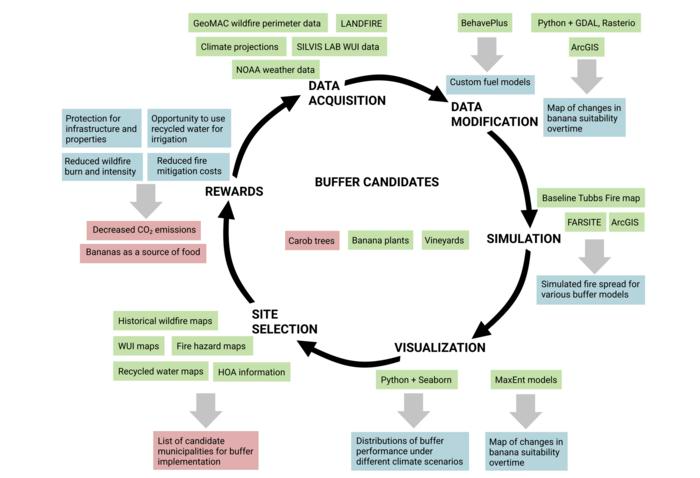A study found that irrigated banana trees could be used as fire buffers to reduce wildfires and provide income for those living in high-risk areas. The risk of wildfires is rising due to climate change.
 Workflow for modeling and analysis of Edible Fire Buffers using existing software tools and datasets, including postsimulation considerations such as site selection and benefits. Green specifies input components, blue specifies output components we validated, and red specifies potential results we discuss but did not validate. Image Credit: Fu et al.
Workflow for modeling and analysis of Edible Fire Buffers using existing software tools and datasets, including postsimulation considerations such as site selection and benefits. Green specifies input components, blue specifies output components we validated, and red specifies potential results we discuss but did not validate. Image Credit: Fu et al.
Between 1984 and 2015, the incidence of wildfires in the Western United States increased by twofold. In addition, a greater number of people than ever before reside in the wildland-urban interface (WUI), a region frequently at high or extremely high risk of wildfire. In the WUI, Barath Raghavan and associates investigate the possibility of banana trees serving as a multipurpose fire buffer.
Banana trees have a high water content, making them perfect for putting out fires. They can produce high-value crops when irrigated with recycled water. The researchers employed a set of models to mimic the behavior of the 2017 Tubbs Fire in Sonoma County, California, if banana tree barriers had been installed.
According to the model, 633-meter-wide banana tree buffers would have lowered the intensity of the fire by 96%, a similar effect to that achieved by treating forest areas with mechanical thinning and managed burning.
When not stopping and calming fires, banana trees have the potential to earn $76,136 per hectare. Bananas will regrow from their corms even if they are burned. Succulent ground covers could keep combustible grasses away from the bananas.
According to the authors, the findings should be broadly applicable to much of California, as well as other Mediterranean-climate places such as Mexico, Chile, Australia, and South Africa, as well as the Mediterranean Basin itself.
Journal Reference:
Fu, X., et al. (2023) Edible fire buffers: Mitigation of wildfire with multifunctional landscapes. PNAS Nexus. doi:10.1093/pnasnexus/pgad315